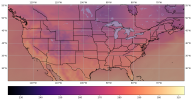I am trying to run MPAS with the global variable resolution mesh 15km-3km with the refinement area being located over CONUS. I have succesfully created the static file and initial conditions, but the model run stops after 30 minutes and 18 seconds. I get no errors and the first history file is created with output until the simulation stops.
I have set the model timestep to 18 seconds. I have tried both the mesoscale_reference physics suite and the convection_permitting suite. I have also tried different combinations of batch nodes and MPI processes and undersubscribed batch nodes, as suggested for this high-resolution grid. The output format for history files is set to "pnetcdf,cdf5" and I have added config_apvm_upwinding = 0.0 in the namelist.atmosphere.
Attached are my namelist, stream file and the log output. My working directory on derecho: /glade/work/kukulies/MPAS-Model
Any help would be very appreciated!
Thanks!
Julia
I have set the model timestep to 18 seconds. I have tried both the mesoscale_reference physics suite and the convection_permitting suite. I have also tried different combinations of batch nodes and MPI processes and undersubscribed batch nodes, as suggested for this high-resolution grid. The output format for history files is set to "pnetcdf,cdf5" and I have added config_apvm_upwinding = 0.0 in the namelist.atmosphere.
Attached are my namelist, stream file and the log output. My working directory on derecho: /glade/work/kukulies/MPAS-Model
Any help would be very appreciated!
Thanks!
Julia

